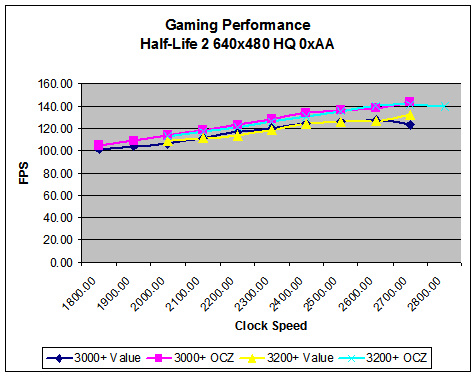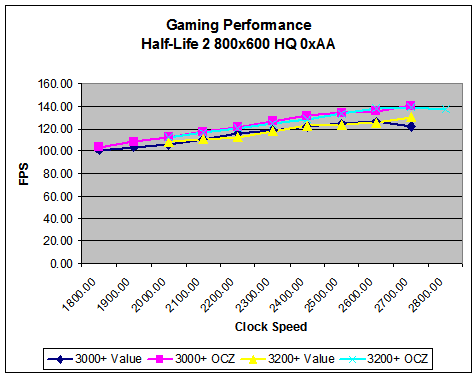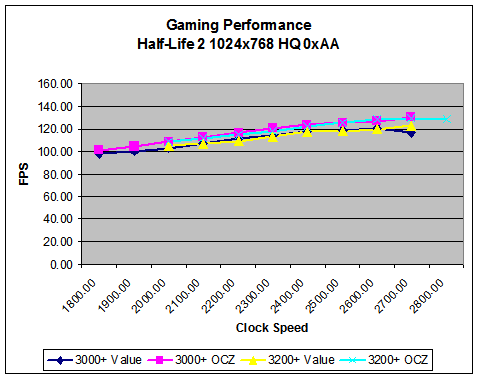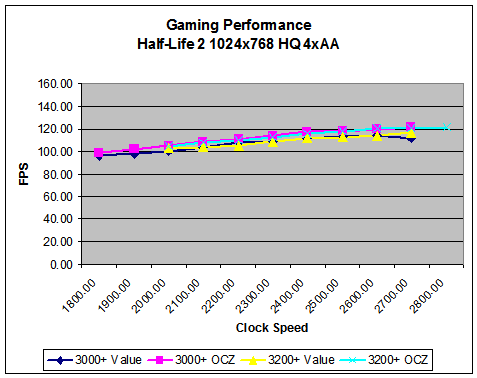Investigations into Socket 939 Athlon 64 Overclocking
by Jarred Walton on October 3, 2005 4:35 PM EST- Posted in
- CPUs
Half-Life 2 Performance
Just as Doom 3 favors NVIDIA performance, Half-Life 2 has done better on ATI cards. Our X800 Pro should provide more than playable results at all the tested resolutions, as HL2 really depends on GPU fillrate for performance. HL2 is also somewhat more CPU limited than other titles, which should give some good performance scaling with our overclocks. Future Source engine games making use of HDR will probably move the bottleneck back towards the GPU, judging by what we've seen in other HDR-enabled titles. Hopefully, Source can manage to provide more realistic HDR modes without cutting performance in half, but we're doubtful.
As with Far Cry, we benchmarked several levels and averaged the results; in this case, we used Anand's C17_12, Canals_08, Coast_05, Coast_12, and Prison_05 demos. Unfortunately, this may be the last time that we use those benchmarks, as the recent Steam upgrade has broken compatibility with revision 7 demos. All of these benchmarks were completed prior to the 9/23 update, luckily, but future overclocking articles will use different demos and will thus not be directly comparable with these scores. For the 22 graphs of the individual levels, we've once again created a Zip file.
In our biggest margin of victory, the OCZ RAM averages a 9% advantage over the value RAM. That's about the equivalent of a CPU upgrade (assuming that you don't overclock), at about the same cost as upgrading the processor. Like Far Cry, the 2T timing hurts performance. One of the things that you might have noticed is that the 10x280 setting has trailed behind the 2700 MHz configurations in most of the games. If we could get it running stably with 1T command rate, it would be better, but we were unable to accomplish this. The value RAM wouldn't even post at 10x280, so whatever limits that we're running into are at least lessened with higher quality RAM.
Just as Doom 3 favors NVIDIA performance, Half-Life 2 has done better on ATI cards. Our X800 Pro should provide more than playable results at all the tested resolutions, as HL2 really depends on GPU fillrate for performance. HL2 is also somewhat more CPU limited than other titles, which should give some good performance scaling with our overclocks. Future Source engine games making use of HDR will probably move the bottleneck back towards the GPU, judging by what we've seen in other HDR-enabled titles. Hopefully, Source can manage to provide more realistic HDR modes without cutting performance in half, but we're doubtful.
As with Far Cry, we benchmarked several levels and averaged the results; in this case, we used Anand's C17_12, Canals_08, Coast_05, Coast_12, and Prison_05 demos. Unfortunately, this may be the last time that we use those benchmarks, as the recent Steam upgrade has broken compatibility with revision 7 demos. All of these benchmarks were completed prior to the 9/23 update, luckily, but future overclocking articles will use different demos and will thus not be directly comparable with these scores. For the 22 graphs of the individual levels, we've once again created a Zip file.




In our biggest margin of victory, the OCZ RAM averages a 9% advantage over the value RAM. That's about the equivalent of a CPU upgrade (assuming that you don't overclock), at about the same cost as upgrading the processor. Like Far Cry, the 2T timing hurts performance. One of the things that you might have noticed is that the 10x280 setting has trailed behind the 2700 MHz configurations in most of the games. If we could get it running stably with 1T command rate, it would be better, but we were unable to accomplish this. The value RAM wouldn't even post at 10x280, so whatever limits that we're running into are at least lessened with higher quality RAM.










101 Comments
View All Comments
Deathcharge - Saturday, October 15, 2005 - link
also what do you think of opteron 144 or 146? the 144 are very cheap and they OC quite well apprentlypmorcos - Thursday, October 13, 2005 - link
Before I comment, you should know that I have been overclocking for 8 years now and literally overclocked all but one of the chips you mentioned in the beginning of this very good article. The HT multiplier was new to me with my most recent DFI NF4-SLI-DR board so I found that extremely useful and plan to see if I can up my speeds...but I digress.I think it would be extremely valuable to TRY to put in words the order with which an overclocker should approach making changes to settings. In other words, which is likely to be the most limiting/critical aspect(s) and from there tweak the others to max the system out.
It would be interesting to say, for example, that you start with a "safe" power settings (which is pretty obviously the limiting factor). For example, let's say your CPU and memory are rated at 1.3 and 2.8 V respectively. Why not go straight to "safe" settings for the two and tweak from there? It seems that the most useful piece of information that is NOT provided by anandtech or anyone else for that matter is a voltage and temp graph of stability/viability for these chips. It would be simple to take 3 samples (at a cost) of each chip and run the test with "average" cooling and find out what is "safe". For example if running all stock settings but upping voltages to say 2.4/3.6 V in the example above, you might see stability up to 1.65 / 3.1 V with the parts catching fire at say 1.8/3.3 V or stable at temp readings for cpu/memory of 44/47C but unstable above that. Once armed with these two graphs of information averaged from 3 chips tested the rest is very straight forward.
You simply set the cpu volts to 1.65 and memory to 3.1 V (the safe settings; check real voltages vis bios monitoring) and now you up your fsb and tweak your memory timings and in a few minutes you are running max.
Why do I think this is more valuable that showing us a graph of your results? Because like many I'm squeemish about upping the voltage on my processor and memory. I'm worried much more about the power-on affects than I am the "long-term" effects.
In computers, there are no long-terms for an overclocker. An overclocker's comp is 60% hardware and 40% software. Their greatest joy is in posting results on their favorite forum. I want to know that when I hit the power button...that the 1.7V setting does NOT have a 10% chance of blowing my processor.
My ramblings. Thanks again for another great article from by far the VERY BEST place in the world to find out how computer parts work.
JarredWalton - Thursday, October 13, 2005 - link
Thanks pmorcos.I'm working on the X2 3800+ OC followup, and I've gone back and done further testing of temperatures and voltages. Chips differ, so the real advice I have on that subject is to test your own chip extensively. I've heard of people doing 2.8 GHz on 1.500V with the Venice chips, but mine won't even POST at those settings. I think 1.65 or 1.70V was required to POST, and even then I couldn't run stable benchmarks without more voltage.
I will also be trying to cover a bit more of the "how to" process in the next one. Consider this the foundation, and the next article will refine the approach a bit. Your comments on what you'd like to see more of are definitely welcome, though, and I'll try to address the order and approach I take next.
Concerning another comment: "I want to know that when I hit the power button...that the 1.7V setting does NOT have a 10% chance of blowing my processor." I'm not quite sure I understand the concern or know how to test that. Are you saying that the power on process has more voltage fluctuations and may therefore toast the CPU in the first second? (I haven't had that happen over the past several months of testing this chip and others in overclocked setups.) I must admit that I'm extremely nervous about the 1.850V I used for running at 2.80 GHz, but even then the chip continued to function (for now - heheh).
Cheers!
Jarred Walton
WhipperSnapper - Thursday, October 13, 2005 - link
That was one of the best computer enthusiast website articles that I've read in a long time, but perhaps I don't get around too much. I'd like to hear more about the problems that spilled over to other components, such as the SATA hard drive (mentioned in the Final Thoughts) and whether or not the overclocking can be isolated to the CPU and RAM. I also wondered if there was a reason why you guys used a SATA hard drive and not an IDE drive and whether overclocking requires a SATA hard drive. (I don't see why it would.)
Also, have you guys tried to do any tests using memory stick heatsinks? Do they actually do anything? That subject might make for a worthwhile article on its own--RAM cooling.
aptinio - Saturday, October 8, 2005 - link
bravo! great article. very informative but not too bloated. can't wait to finally upgrade my amd k6-II with 1mb l3 cache on the motherboard! lol!Kougar7 - Thursday, October 6, 2005 - link
Thank you for the excellent, comprehensive, and very thorough article! :-) It must have taken a massive amount of work and time to complete. It’s answered my recent musings about my own Crucial value ram, which looks much nicer now! It’s also solved a question about OCing with recent AMD 64 chips, amongst also correcting a few personal misconceptions I’ve had.I just wish to ask if you plan to include a similar article on OCing with P4s? I personally run a 2.8C (Northwood) @ 3.4 rock solid at the 3.4C’s default voltage, but am now wondering exactly what performance hits, if any, that I’ve taken from having to use a 5:4 CPU:DRAM ratio instead of the previous 1:1, even though I’ve kept it at DDR390 and the timings better than specs.
I’m planning to bench the differences from a 1:1 ratio, a 3:2 ratio at highest speed I can get (sub-DDR333), my current setup, and finally one other setting where I got the value memory to run 2-2-2-6 timings, to get a more solid idea on which performs best with some solid figures.
Although the core and the platform itself both have both changed, I’d still be interested in a Intel processor based test! Perhaps instead of a P4, maybe a Pentium “D” OCing article similar to what you have planned with the X2 3800+? ;-)
I’m very much looking forward to your X2 3800+ OCing review!! You rock :-D Thanks in advance for it!
JarredWalton - Thursday, October 6, 2005 - link
I'm trying to get a socket 775 motherboard that will overclock well with Pentium D 820. Once I get that, I can give it a go. I've also got a Pentium 4 505 and a 540 that I want to run some similar tests on. First, though, I need an appropriate motherboard.clue22 - Thursday, October 6, 2005 - link
so basically what the everybody is saying about the value RAM vs. low latency more expensive RAM is that for the athlon 64 it is basically a waste of money (i.e. you only get about 5% performance gain), but usually spend 100% or more money to get the "better" RAM. i have to build a couple of systems pretty soon and now i believe that my money would be better spent on 2GB of value RAM vs. 1GB of the more expensive stuff. does anyone know of a test that has been run with 2.5-3-3-8-1t vs. 2-2-2-5-1t? also why does every mid-range/gaming/hot-rod price guide ever recommend the either the samsung tccd (or tcc5) or winbond bh5/ch5 based memory if it has so little effect on performance. finally is it even important anymore (if it ever was) to get matched pairs of memory that are bundled together (supposedly manufactured at the same time)? i was looking at some corsair (had good experience with them in the past) xms3200xl RAM but now i think i should get more of their value select memory instead.thanks
RupertS - Wednesday, October 26, 2005 - link
so basically what the everybody is saying about the value RAM vs. low latency more expensive RAM is that for the athlon 64 it is basically a waste of moneyThis may not be a general rule.
It may just be that at this stage of development for GPU's, CPU's and memory, memory has more than enough capacity - it is not the choke point. If GPU and CPU speed were to improve while memory speed stayed the same, you might reach the point where increasing GPU and CPU speed was non-productive for games, while overclocking memory provided large performance improvements.
rabbit fighter - Wednesday, October 5, 2005 - link
Where was this explained? He said the 3200 was better in the first paragraph and that he would explain later, but I can't find the later explanation!